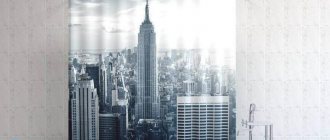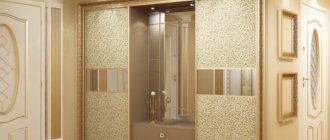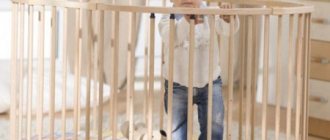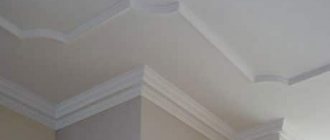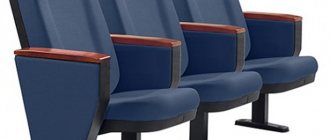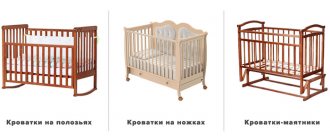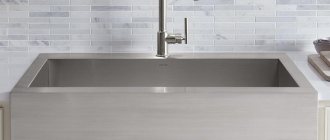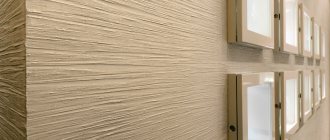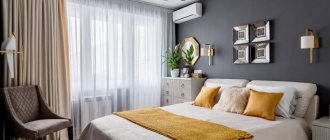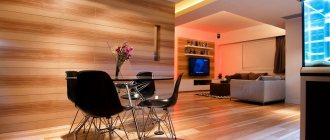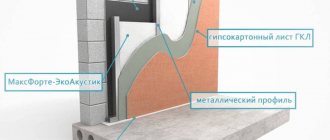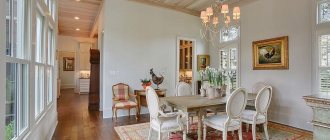According to the type of joint, plastic panels are divided into:
Seamless
the most common type of panels recently. However, a seamless joint is called quite arbitrarily. No matter how you join the panels, the joint will still be visible, especially if the panels are white and glossy, as in the photo:
Those. the surface, of course, will be quite flat and smooth, but it will not be possible to achieve the ideal, as when using seamless stretch ceilings or drywall.
In addition, plastic panels are sometimes deformed due to poor storage or transportation conditions, or they are simply of poor quality; it is almost impossible to join such panels without a seam. If several planes will be sewn up in one room (for example, the ceiling and walls) or one plane (for example, the ceiling) in different rooms, then you can sort through the panels, selecting those curved in one direction. The fact is that the panels, as a rule, are packaged so that the front surface is in contact with the front, and the back surface with the back, thus reducing the risk of scratches (reduced, but not eliminated) and if the panels are curved, then one plane is taken for covering every second, i.e. half of the panels are from the pack, the rest are used to cover another surface. Moreover, the frame for seamless panels must be made with maximum precision. In a word, if increased aesthetic requirements are imposed on surfaces finished with seamless panels, then such panels must be selected with special care. If possible, it is better to check the quality of the panels immediately in the store by trying to join two panels from a pack.
Seamless plastic panels have approximately the following cut:
This allows panels to be joined virtually seamlessly:
The width of seamless panels is usually 20, 25, 30 and 33 cm.
Embossed
Such panels are often called “lining”, as they imitate wooden “lining” panels.
As a rule, this is the cheapest or most expensive type of plastic panels. The use of such panels is most preferable when installing ceilings on wooden structures and, in general, if slight deformations of the load-bearing structures are possible. For example, in the private sector there are often cases when a house “breathes” due to an incorrectly made foundation, i.e. In summer, cracks on the walls increase, and in winter they decrease, or vice versa. In such cases, the panels may also diverge or converge slightly, but the raised joint will make such a divergence within a few millimeters almost unnoticeable.
Plastic panels - lining have approximately the following section:
Therefore, when joining the panels, a relief seam is obtained:
Sometimes the panels have a cut like this:
This allows you to speed up the installation of panels, which is important for large volumes of work. Plastic panels - linings come in widths of 10, 12.5, 15, 20, 25, 30, 33 cm.
With rustication
This is a cross between seamless and embossed panels. Panels with such a joint are not found very often, but they do occur. The surface finished with such panels will look something like this:
In cross-section, the joint of the panels looks like this:
The width of the rusticated panels that I had to work with is 38.5 cm.
In addition to these important characteristics, the following influence the choice:
Parameters of plastic panels:
Designer:
- Color . Everything here is purely individual and without any recommendations. But as a rule, if difficulties arise with choosing a color, then white panels are purchased. White and black are universal colors and go well with any other.
- Drawing. If the plastic panels have a pattern, then this pattern imitates some material or pattern. Almost always it is marble, granite, sections of rocks, but imitation of mats, fabric, as well as wood, leather, or an ornamental pattern are also possible. The more contrasting and multi-colored the pattern, the stronger the effect on the nervous system. In addition, sometimes it may be difficult to select a pattern; in this case, panels need to be purchased with a good margin for cutting.
- Gloss level. Plastic panels can be matte, glossy, semi-gloss. There is no difference between them other than design preference. To obtain gloss, a lamination layer is applied to the front surface of the panels.
Operational and design:
- Surface texture. As a rule, plastic panels have a smooth surface. But on expensive panels with a pattern that imitates natural materials, the surface may be slightly embossed. On the one hand, this brings the appearance of the panel as close as possible to natural material, on the other hand, it is more difficult to care for such panels and therefore, in my opinion, it is not rational to cover the walls in the bathroom and kitchen with such panels, but again, there are no comrades according to taste and color.
- Durability. Of course, strength and plastic panels are poorly compatible concepts. It's easy to damage plastic panels. I think everyone has seen the disastrous results of using plastic panels for wall decoration in public places. However, the thicker the walls and partitions (stiffeners) of the panel, the stronger it is, although recently the thickness of the walls and stiffeners has only been decreasing.
- Chemical resistance. Any plastic panels can easily withstand treatment with modern detergents, but it is better not to take risks and use detergents with a minimum content of chemically active components.
Quality:
In addition to the fact that the panels may be “misbehaved,” the front surface of the panels may have scratches, dents, cuts, permanent stains, poor-quality lamination layer and other defects that are quite easy to see after unpacking the panels. It’s better to do this right in the store, so as not to take the panels back later and not quarrel with the sellers.
Due to the nature of the bathroom, few finishing materials can be used when renovating this room. But if earlier it was only ceramic tiles, now the latest developments in this area allow you to have a larger selection of materials that will help you realize any of your fantasies. And as an example, we will look at the use of plastic panels for the bathroom. They are also called PVC panels.
Today, they confidently occupy second place after tiles, since they have undoubted advantages, which we will discuss below, and also allow you to quickly and efficiently decorate a bathroom at minimal cost. Even if you are not a professional in this matter, you can completely cope with all the work yourself.
In addition, in any hardware store you will find a large assortment of plastic sheet panels that imitate not only all kinds of textures, but also a wide color palette and patterns. This allows the use of plastic panels in any room, regardless of its size, although designers recommend using light shades in small bathrooms to make it visually larger.
Plastic panels for bathroom
When purchasing plastic sheet panels, try to carefully inspect them so that they have as few protrusions and cracks as possible, since in the future moisture will accumulate in these places, which will lead to the growth of mold and mildew, not to mention dark spots that are unlikely to decorate your bathroom. And if you still want to combine tiles and ceramics, then plastic sheet panels for tiles are suitable for you.
Installation
You have two options for attaching plastic sheet panels:
- using self-tapping screws;
- or glue.
In the first case, you will have to attach guides to the walls, which are also sold in hardware stores. The advantage of this option is that you will not need to perfectly align the walls in the bathroom, although leaving bumps or depressions is also not recommended. The downside is that you will have to spend a lot of time and effort to secure the sheet panels, and also drill a lot of holes for self-tapping screws.
Sheet panels for bathroom
In the second case, you will simply need to carefully plaster the walls, since you will be gluing plastic panels to a bare surface, without using any other fasteners, which means everything must be perfect, otherwise it will affect the quality of the finish. Here you will save a lot of time, but the disadvantage of this option is that if you want to remove the panels and replace them with new ones, you will have to tinker a lot, tearing them off the walls in the literal sense of the word. So it's up to you to decide which one to choose.
If you settled on guides, then you will attach them horizontally to the floor under the ceiling, below and in the middle. But if you want to make a more durable structure, you can additionally secure a pair of guides at about a quarter of the distance from the floor to the middle of the wall, repeating the same at the top.
Here's what you have to do when installing plastic sheet panels in the bathroom:
But if the walls in the bathroom are covered with plasterboard, then the best option is hidden fastening brackets, since this material gives perfectly smooth walls and you do not have to install guides and thereby save centimeters in small rooms, not to mention time. But if you have concrete or brick walls, then for each individual bracket you will have to drill holes and put pins in them. But when installing plastic panels on guides, you will screw screws into the panels or use fastening brackets.
By the way, if you bought an apartment in a new building, then it is better to use plastic sheet panels in the bathroom, because in the first 3-4 years, the house will shrink, which slightly deforms the walls and can completely warp the tiles.
Paneled walls
We use self-tapping screws
In order to install plastic panels on the sheathing using staples or screws, you will need the following tools and materials:
- PVC panels in the required quantity, plus with a small margin;
- profile for sheathing construction;
- plastic profiles or wooden blocks;
- hammer;
- construction stapler with a set of staples or self-tapping screws (nails);
- a construction knife and a hacksaw for metal with a fine tooth;
- screwdriver;
- roulette;
- pliers;
- pencil or marker;
- building level;
- ladder.
Before attaching plastic decorative panels, treat the finished surface with special moisture-resistant compounds that prevent the growth of fungi. It is better to use plastic profiles, because the wood will collapse under the influence of moisture in the bathroom. Mount the profiles on the wall horizontally to the floor with a distance of up to 5 cm, while you will install the panels themselves perpendicularly, otherwise moisture will accumulate in the joints, which will lead to the growth of fungus between the plastic bath panels.
When installing profiles, constantly monitor their installation using a building level. Otherwise, the PVC panels will not stand up straight and the coating will have differences. In most cases, fastening begins from the left corner to the right or from the far corner to the doorway. But you can be guided by your ideas regarding ease of installation.
There is a huge selection of panels on the market
In the corner where you start work, install the finishing element, since you will not be able to do this later. Each of the PVC panels consists of two fastening shelves: on the left there is a narrow part (shelf), which you will insert into the groove of the already installed panel, and on the right there is a wide shelf, thanks to which the panel is fastened to the sheathing with screws or staples.
The first PVC panel is inserted with a narrow shelf into the groove of a pre-installed corner, and attached to the sheathing with staples (screws). All other plastic sheet panels are installed according to the same scheme - one is inserted into the other and secured. The main thing is that all parts fit tightly together.
Where the plastic panels come into contact with corners, window openings or door frames, you will attach special mounting components (finishing elements). This will allow you to beautifully and neatly decorate areas near windows and doors, as well as corners. But in order for air to flow under the fixed plastic panels, you should leave a small gap near the floor and under the ceiling. Additionally, these gaps will make it possible to compensate for changes in the linear dimensions of PVC panels under the influence of temperatures in the bathroom.
Technology does not stand still, and you can attach sheet panels using a special plastic profile and clips. What are the advantages of this method:
Liquid Nails
If you have good, even walls in your bathroom, then you can do without lathing and immediately glue plastic sheet panels to the wall. You can use a product such as liquid nails or other special glue designed for this type of work in the bathroom. But keep in mind that you will not be able to use those formulations that contain organic solvents.
For work in this case, you will need the following tools:
- glue brush;
- putty knife.
- a soft sponge or rag to remove excess glue.
Here's what you have to do to make sure everything works out correctly and you don't have to redo anything:
At the same time, do not forget about installing finishing elements to make the bathroom interior beautiful.
What does a high-quality PVC panel mean?
Basically, plastic panels, to save the budget, replace more expensive materials that are designed for certain premises. When installing PVC panels in a bathroom, you need to take into account that it has a special microclimate. Constant high humidity and temperature changes in this room lead to the growth of mold, mildew and corrosion.
In connection with these indicators, it is necessary to buy PVC panels that will fully suit the environment of the room. High-quality PVC panels must have a number of indicators:
- corrosion resistance;
- resistance to temperature conditions;
- high moisture resistance;
- mechanical strength.
What is this material?
The facing material is plastic panels. They have internal perforations and a pattern printed on the front part. The length of the panels is usually 2 m 70 cm or 3 m. Material of this size is most often enough to decorate any premises. The cost of the material is low, which attracts buyers. Tiling can cost several times more. The panels are easy to install.
The stores offer a wide range of materials. You can choose any color. You need to choose plastic panels in light colors for a small area. Several different colors go well together.
The panels in the bathroom can be installed independently, without the involvement of outside force. Their standard height allows you to close the gap from floor to ceiling. The width is usually 25 cm. But when choosing, you need to look at the dimensions, since they may be different for some manufacturers. For 1 m of wall or ceiling, 4 panels are needed. It's quite easy to calculate the total amount of material per room. For fastening, you also need to purchase guides and corners, which are called profiles or moldings.
Wide selection of design options for PVC panels
By the way, in terms of textured finish, plastic panels are not inferior to ceramic tiles, since today the leading manufacturers of such finishing materials produce them in different designs. Thanks to this, each person has the opportunity to choose exactly the option that builds it, based on his artistic preferences. So, if you wish, decorating a bath in the desired style will not be difficult, and a qualified interior designer can suggest a suitable design, also providing advice on color and range.
Finally, we can only note that the only disadvantage of plastic panels is that they are not very strong in physical strength, which should be taken into account when using the bathroom. In all other respects, this material is not much inferior to tiles, and therefore can be perfectly used as a full-fledged finishing material for a good bathroom renovation.
Advantages of PVC panels and bathroom finishing
Finishing panels have a number of advantages compared to other materials:
- excellent moisture resistance;
- low cost;
- rich color range;
- the ability to join parts vertically and horizontally;
- durability;
- wear resistance;
- ease of assembly.
Moisture resistance allows the material not to get wet or deform. Special locks form a solid canvas, through which water also does not penetrate. Plastic costs much less than tiles. Various colors allow you to create any design in the room. Holes should be cut for lamps and pipes. No special experience is required to work with panels.
The work of installing plastic is carried out in several stages:
- it all starts with preparing the wall;
- the fastening method is selected;
- panels are cut to length;
- a plastic corner is placed in the corner;
- the panel is inserted and secured to the sheathing;
- the remaining parts are installed.
First you need to clear the room of unnecessary things. Then the old finish is removed from the walls. If the wall is smooth and does not require repair, then it is enough to get a good glue to which the panels will be glued. But this method is not the most common. It is better to make a small sheathing with your own hands from special guides or wooden slats treated against moisture. The sheathing elements are attached to the wall using dowels. The distance between the slats is 40-50 cm. The flatness is checked by level and rule.
When installing panels yourself, you most often have to cut them to width. This can be done with a sharp knife. After completing the main work, the joints and corners can be sealed with sealant to prevent moisture from entering. It is recommended to install plastic panels in a house older than 3-5 years. A new house can settle and damage the cladding. If the bathroom has a heated towel rail, then a distance of 3-4 cm must be left between it and the lined surface, otherwise the plastic may be deformed due to temperature.
Lined surfaces are very easy and simple to clean, they drill well, and moisture does not pass through them. Tools and materials are required to complete the work.
Among modern finishing materials, plastic panels are very popular. And all this because they are light, hygienic, can be easily attached to walls made of any material, are not afraid of moisture and are not subject to rotting. Plastic panels made of polyvinyl chloride (PVC) are made by extrusion, which gives them the necessary strength and rigidity. In this article we will define the main criteria for choosing this finishing material.
Today, the industry produces a huge selection of plastic panels produced in Turkey, China, Russia and Ukraine, differing in appearance, color, degree of gloss and other characteristics. In any hardware store, your eyes widen from their abundance and variety, and confusion sets in: so which panels to choose?
All panels are conventionally divided into ceiling and wall. There is no direct ban on the use of wall panels on the ceiling, and ceiling panels on walls, but a light test with finger pressure clearly interprets that, having low strength, these panels cannot be used for wall cladding.
An additional distinguishing element is the length. Typically, ceiling panels are 6 or 12 m long, and wall panels are shorter - 2.7, 3 and 6 m.
The thickness of ceiling panels is gradually being reduced by manufacturers; previously it was 8mm, then it became 7mm, now 5 and even 4mm are found, and wall panels are usually produced with a thickness of at least 10mm.
Many buyers consider the cheapest panels, but do not want to pay attention to the fact that a quality product cannot be cheap.
After all, the vast majority of Chinese plastic panels are made from low-grade raw materials, poor adhesives and varnishes. In the future, they will quickly lose their appearance and, most importantly, will begin to release toxic substances; even the possibility of provoking an allergic reaction of the human body cannot be ruled out.
So, you should purchase panels thoughtfully, thoroughly considering and paying attention to the following factors. The main types of plastic panels are:
- 1. Plastic lining - used in the decoration of walls and ceilings; special fastening brackets are used for fastening. Relief panels are often called lining because they create an imitation of a wooden “lining” panel. 2. Plastic panels for tiles. It is advisable to use square tiles with a width from 30 to 98 cm. 3. Sheet panels - resemble plywood. Their main difference lies in installation - fastening is done with glue or nails. The joints are sealed with sealant or sewn up with slats that have the structure and color of the panels
From the point of view of room design, emphasis should be placed on the fact that there is a varied color palette of panels available for sale, allowing you to satisfy any desire of the buyer.
All panels are conventionally divided into glossy, matte and semi-gloss.
Their technical characteristics are the same, and the difference lies solely in the surface layer. This is achieved by using varnish, which creates a layer of protective film on the front surface.
When choosing plastic panels, you need to carefully study the following parameters:
- 1. Thickness of the front part - greater thickness has significant strength.
2. The number of stiffeners - the more, the stronger the panel. The external condition of the stiffeners must be identical without visible deformations. A high-quality panel has more weight, which corresponds to its thickness and the number of stiffeners.
3. The outer surface must be uniformly painted, and viewing the stiffeners is not permissible. It’s easy to check the quality of the panels - just press it down with a deflection of up to 50% and look at the result. High-quality panels do not leave dents, mainly due to the low chalk content.
4. The panels must fit tightly and rigidly into the groove. The type of joint in panels can be seamless and embossed. The most common currently is seamless, but it should be called conditionally seamless, because even with the highest quality installation, the joint is still visible.
Poor manufacturing or improper storage and transportation of plastic leads to its inevitable deformation and, as a consequence, to the impossibility of ideal joining of its parts.
Accessories and tools
Covering a bathroom with plastic panels is a fairly simple job; anyone can do it with their own hands. To give your bathroom a beautiful and stylish look, you don’t need any special skills or a lot of time. To renovate a room, you will not need to carry out global preparatory measures when cleaning walls and partitions.
Before tiling the bathroom, you should purchase the following tools and materials:
- PVC panels;
- wooden blocks;
- a profile made of plastic, metal or wood along with brackets for fastening (it is better to use brackets with a metal base);
- construction stapler for fixing products;
- self-tapping screws;
- you can use a hacksaw to cut a metal base; craftsmen advise purchasing a product with fine teeth;
- knife for installation;
- construction hammer;
- electric grinder, which will be used to cut products;
- screwdriver;
- tape measure for construction work;
- building level;
- a hammer drill that has a “drill” function;
- a regular pencil or markers, you should use them to make markings;
- pliers;
- ladder.
In order for the tiling to be carried out correctly, it is recommended to first install lathing on the walls of the bathroom. It is made of plastic or metal profile. If the work is carried out in spacious bathrooms, PVC panels can be mounted on a wooden frame. After preparing the items necessary for the work, you can begin the installation itself. The work should be performed sequentially to avoid errors.
Characteristic advantages and disadvantages of plastic panels
Like any material, plastic panels have their advantages and disadvantages. Let's start with the positives.
According to manufacturers, all plastic panels are environmentally friendly, do not burn, have soundproofing properties, are lightweight, have good moisture resistance, durability, are easy to clean and, moreover, are inexpensive.
The disadvantages of plastic panels are as follows:
- low strength, scratches, dents and chips remain on the surface (one sufficiently strong blow or strong pressure leads to a crack); panels have a limited scope of application; initially there is a specific smell; Being a universal material, plastic panels are usually used for interior decoration.
How to choose the right PVC panel: advantages and disadvantages
PVC panels are made from polyvinyl chloride, which does not burn.
They are made by extrusion; the result is a panel consisting of two surfaces, between which there are many plastic longitudinal cells. Advantages of the material:
- Easy
- Eco-friendly, does not harm the environment
- Insensitive to temperature changes
- Has good sound insulation
- Resistant to moisture, does not form mold - can be used for bathrooms and kitchens
- Easy installation
- Cheap price
- Wide range of colors and patterns
The material also has its drawbacks, which are important to remember when choosing PVC boards: the most important thing is that such a material has low strength, so they can only be installed in rooms where the strength of the wall or ceiling covering does not necessarily have a safety margin.
Also, PVC panels are usually divided into wall and ceiling. They differ only in size, but no one forbids using them the other way around. Thus, wall panels reach a maximum length of 6 meters, while ceiling panels are up to 12 meters, while the thickness of wall panels is 8-10 mm, and ceiling panels are less than 8 mm.
The panels can be seamed or without a seam - but even with the latter it is not possible to make the joint completely invisible. Usually, the joints of seam panels are decorated in such a way that beautiful effects appear on the surface.
